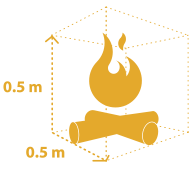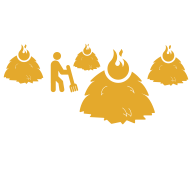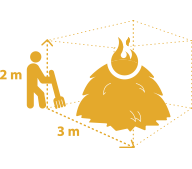Open fire and safer burning
To help prevent wildfires, please take the time to learn how to burn safely.
Before lighting a fire of any size, always check for any BC Wildfire Service open fire prohibitions in your area. Also, be sure to check with your local government for any bylaw restrictions in your area.
On this page
- Outdoor stoves
- Category 1 campfires
- Category 2 open fire
- Category 3 open fire
- Category 4 resource management open fire
- Offences and fines
Outdoor stoves
An outdoor stove, as defined in the Wildfire Regulation, refers to an open fire device that:
- Is used outdoors for cooking, heat or ambience
- Burns charcoal briquettes, liquid or gaseous fuel as the fuel source
- Is certified by the Canadian Standards Association (CSA) or the Underwriters Laboratories of Canada (ULC)
- Has a flame height less than 15 cm
Outdoor stoves may include devices such as:
- Propane campfires
- Camp stoves fueled with gas or briquette
- Gas and briquette barbecues
- Pizza ovens fueled with gas or briquette
Legislative requirements for outdoor stoves
Any person using an outdoor stove must:
- Not light an outdoor stove when outdoor stoves are prohibited
- Only light a fire in an outdoor stove if conditions are safe and will continue to be safe
- Take reasonable precautions to ensure the fire is contained in the stove and the fire is fully extinguished before leaving the area
- Carry out fire control immediately if the fire spreads out of control beyond the outdoor stove and report the fire as soon as possible
Safer burning tips for outdoor stoves
During category 1 campfire prohibitions, only outdoor stoves that meet the standards described above may be used.
To reduce wildfire risk when using an outdoor stove, follow these basic safety tips:
- Operate the device as specified by the manufacturer's safety instructions
- Ensure the device is on a non-combustible surface
- Create a fuel break (sometimes called a firebreak) by removing any flammable material within one metre of the device
- Always be sure to turn the device off and ensure the fire is completely extinguished before leaving the area
- Never dispose of hot cools; ashes must be cool to the touch before being disposed of
Category 1 campfire
A category 1 campfire, as defined in the Wildfire Regulation, refers to any fire that is:
- No larger than 0.5 metres high by 0.5 metres wide
- Used for recreational purposes or by a First Nation for ceremonial purposes

Legislative requirements for category 1 campfires
Any person burning a category 1 campfire must:
- Not light a fire during a category 1 campfire prohibition
- Only light a fire if conditions are safe and will continue to be safe
- Establish and maintain a fuel break (sometimes called a firebreak) around the category 1 campfire.
- Have at least one person watching the fire that is equipped with at least one firefighting hand tool or 8 litres of water
- Ensure the fire is fully extinguished before leaving the area
- Carry out fire control immediately if the fire spreads beyond the fuel break or becomes out of control and report the fire as soon as possible
During a category 1 campfire prohibition, only CSA and ULC approved devices which use charcoal briquettes, liquid or gaseous fuel as the fuel source may be used, and flame length must not exceed 15 cm. Under extreme conditions, these devices may be prohibited as well.
Safer burning tips for category 1 campfires
Approximately 6% of wildfires in B.C. are caused by campfires every year. Members of the public can ensure they don't contribute to the problem by following some basic campfire safety rules.
Before you burn:
- Check to see if there is a category 1 campfire prohibition in your area
- Check with your local authorities for any bylaw restrictions before lighting a fire of any size
- If you are planning for a fire larger than 0.5 metres by 0.5 metres, you must comply with the conditions specified in the Wildfire Regulation for category 2 or category 3 open fires
- Check the current and forecast weather conditions. If it's windy or wind is in the forecast, don't burn
Choosing your location:
- Your fire should be on level ground that is a safe distance from tent walls, shrubs, trees or other flammable materials
- Do not build your fire beneath low-hanging branches
- Use a rock ring, fire pit or other non-flammable barrier around the fire to prevent it from spreading
- Create a wide fuel break (sometimes called a firebreak) around your fire by scraping the area around your fire down to bare dirt to remove any flammable material
During your burn:
- Maintain your campfire to a size no larger than 0.5 metres high by 0.5 metres wide
- Have at least one firefighting hand tool or 8 litres of water on hand to extinguish the fire. A firefighting hand tool could be a shovel, axe, Pulaski, backpack pump or fire extinguisher
- Never leave your campfire unattended for any amount of time
Extinguishing your campfire:
- Before you leave the area or go to bed for the night, your fire must be fully extinguished
- When you are ready to put your fire out, pour lots of water on it, stir the ashes, then pour more water on it. Continue doing so until the ashes are cool to the touch
Additional resources
For more information on responsible campfire use, download a copy of:
Category 2 open fire
A category 2 open fire, as defined in the Wildfire Regulation, refers to any fire that burns:
- Material in one pile not exceeding 2 metres in height and 3 metres in width
- Material concurrently in 2 piles, each not exceeding 2 metres in height and 3 metres in width
- Stubble or grass over an area that does not exceed 0.2 hectares (2,000 square metres)
Legislative requirements for category 2 open fire
Any person burning a category 2 open fire must:
- Not light a fire during a category 2 open fire prohibition
- Only light a fire if conditions are safe and will continue to be safe
- Establish and maintain a fuel break (sometimes called a firebreak) around each pile, grass or stubble area to be burned. See Policy 9.12 for more information on fuel breaks
- Ensure the fire is watched by at least one person equipped with a firefighting hand tool to keep the fire from spreading beyond the fuel break
- Have a fire suppression system adequate for fire control available near the burn area. A fire suppression system means a system for suppressing fire by delivering water, a suppressant, a surfactant, or any combination of these substances
- Carry out fire control immediately if the fire spreads beyond the fuel break or becomes out of control and report the fire as soon as possible
- Ensure the fire is extinguished before leaving the area for any amount of time
Smoke is a health hazard regulated under the Open Burning Smoke Control Regulation. On the day you are planning to burn, check the Ventilation Index Interactive Map to view conditions in your area and see if burning is allowed.
Safer burning tips for category 2 open fire
Category 2 open fire is one of the leading causes of wildfire in the spring. To reduce this risk, follow the steps below for safer category 2 open burning.
Before you burn:
- Check to see if there is a category 2 open fire prohibition in your area
- Check with your local authorities for any bylaw restrictions before lighting a fire of any size
- To reduce risk and smoke, consider whether you need to burn at all. Other options may include composting and chipping; contact your local government for alternatives to dispose of yard debris
- Check the current and forecast weather conditions. If it's windy or wind is in the forecast, don't burn
Choosing your location:
- Your fire should be a safe distance from buildings, shrubs, trees or other flammable materials
- Do not build your fire beneath low-hanging branches
- Create a wide fuel break (sometimes called a firebreak) around your fire by scraping the area around your fire down to bare dirt to remove any flammable material
During your burn:
- Ensure at least one person is equipped with a firefighting hand tool for fire control. A firefighting hand tool could be a shovel, axe, Pulaski, backpack pump or fire extinguisher
- Have a fire suppression system adequate for fire control available near the burn area. A fire suppression system means a system for suppressing fire by delivering water, a suppressant, a surfactant, or any combination of these substances
- Never leave the fire unattended for any amount of time
Extinguishing your burn:
- Ensure your fire is fully extinguished before you leave the area
- When you are ready to put your fire out, pour lots of water on it, stir the ashes, then pour more water on it. Continue doing so until the ashes are cool to the touch
Additional resources
For more information on safer open burning practices, download a copy of:
Category 3 open fire
A category 3 open fire, as defined in the Wildfire Regulation, refers to any fire that burns:
- Material concurrently in 3 or more piles, each not exceeding 2 metres in height and 3 metres in width
- Material in one or more piles, each exceeding 2 metres in height or 3 metres in width
- One or more windrows, not exceeding 200 metres in length or 15 metres in width
- Stubble or grass over an area exceeding 0.2 hectares (2,000 square metres)

To ensure you are burning safely and in compliance with provincial legislation, visit the category 3 open fire page.
Category 4 resource management open fire
A category 4 resource management open fire, as defined in the Wildfire Regulation, refers to an open fire used for resource management that:
- Burns unpiled slash over an area of any size
- Is not a category 1, 2 or 3 open fire
- Is lit, fueled or used for silviculture treatment, forest health management, wildlife habitat enhancement, fire hazard abatement, ecological restoration, range improvement or purposes identified by Indigenous peoples
This category refers to cultural and prescribed fire. Prescribed fire describes the deliberate use of fire to achieve a range of land stewardship objectives. It can help reduce the intensity of naturally occurring wildfires while returning an integral process to the land base.
These fires are carried out by experienced practitioners and can take many months or even several years to plan, depending on the size, complexity and objectives the proponent is trying to achieve.
Legislative requirements for category 4 resource management open fire
The person who lights or maintains a category 4 resource management open fire must:
- Submit a burn plan to an official and receive their approval in writing, or have an agreement in effect (referred to in Section 23.1 of the Wildfire Regulation) between the Province and an Indigenous governing body
- Register the burn with the BC Wildfire Service and obtain an Open Fire Tracking System (OFTS) burn registration number
- Only light a fire if conditions are safe and will continue to be safe
- Ensure the resource management fire is lit, fueled and used in accordance with the approved burn plan and does not spread beyond the area specified in the burn plan
- Ensure the fire does not exceed the capacity for timely action to prevent any fire spreading beyond the fuel break
- Carry out fire control immediately if the fire spreads beyond the area specified in the burn plan and report the fire as soon as possible
- Ensure the fire is fully extinguished by the date specified by the official or person who issued the OFTS burn registration number
Additional resources
To learn more about cultural and prescribed fire in B.C., visit:
- The prescribedfire.ca webpage to view case study videos and learn more about the planning and delivery of prescribed fire projects
- Our Cultural and prescribed fire webpage to learn about the importance of fire, cultural burning and prescribed fire, and to access additional cultural and prescribed fire resources
- Our Latest News page to read information bulletins and learn more about specific projects
Offences and fines
Remember, if you choose to conduct any open burning, you are responsible for what you burn.
If your open fire escapes and results in a wildfire, you may be fined up to $1 million, be sentenced for up to 3 years in jail, as well as be responsible for all firefighting and associated costs.
For information on open fire prohibition offences and fines, visit our Fire Prohibitions and Restrictions page or read the summary of wildfire-related offences and fines in B.C.
If you witness an illegal open fire on Crown land, call the Report All Poachers and Polluters (RAPP) hotline toll-free at 1-877-952-7277 (RAPP), or submit a report online.
To report illegal fires in a local fire department's jurisdiction, call 9-1-1.

